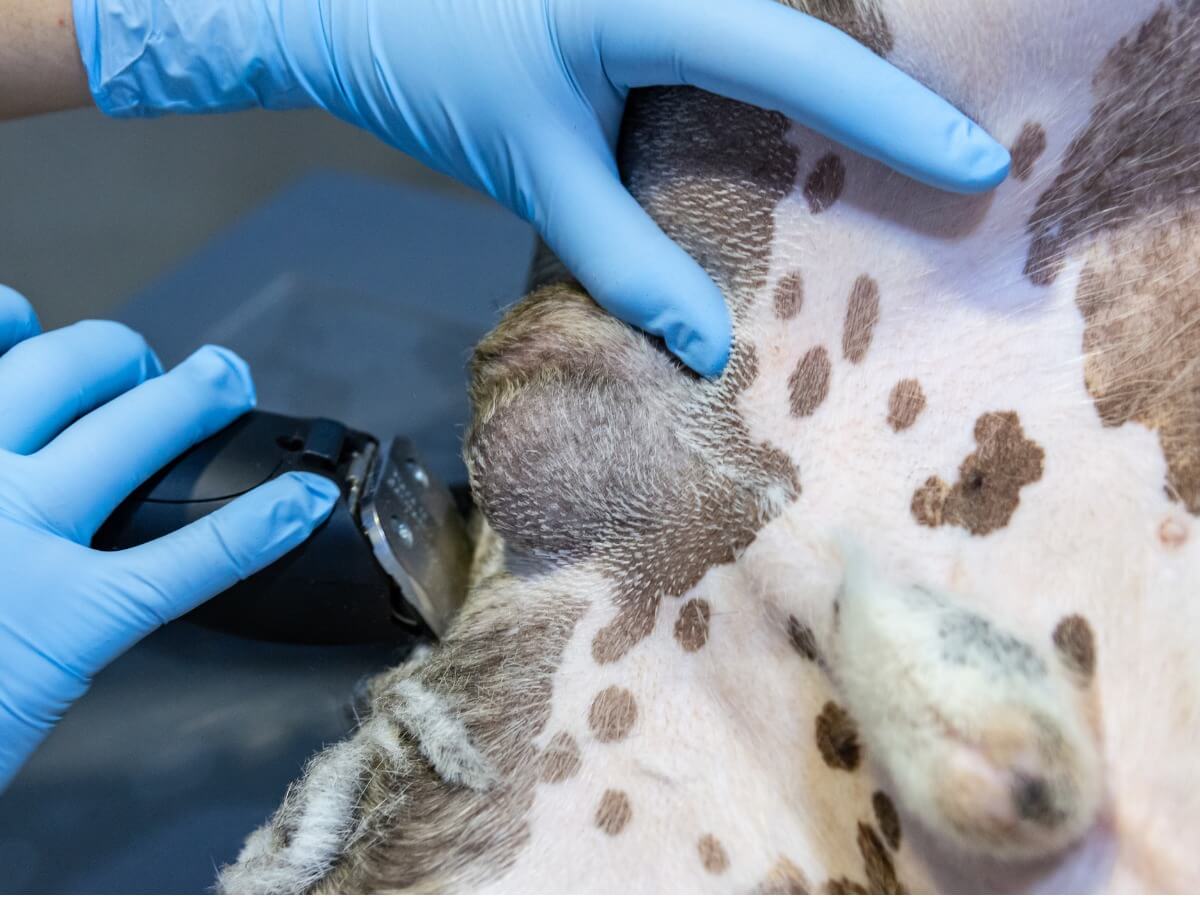Paraphimosis in Dogs: Characteristics, Causes and Treatment


Written and verified by the biologist Samuel Sanchez
Paraphimosis in dogs is a condition that not many dog owners are aware of, but there are quite frequent consultations in the clinic. Sex and reproduction tend to be taboo in many cultures and it wasn’t going to be any different with pets. Because of this, there’s very little general knowledge about the canine reproductive system, how a male dog’s penis works, and the possible pathologies that can occur in this organ.
With the etymology of the term itself, we can already get an idea of what it consists of. Para means “beside” or “next to”, while phimosis refers to a constriction in the orifice of the foreskin. If you want to know more about this condition, continue reading this space.
What is paraphimosis in dogs?
The male reproductive system of dogs is composed of the testicles, the epididymis, the vas deferens, the penis, the foreskin, and the accessory glands. The penis is divided into the root, shaft, and distal portion or glans, and has 4 pairs of extrinsic muscles: retractor, ischiocavernosus, bulbospongiosus, and ischiourethral.
When observing a dog’s genital apparatus, the external manifestation is the foreskin, that is, the skin and other tissues that surround and protect the non-erect penis. The penis itself is covered by a moistened mucous membrane within the preputial cavity, hence its appearance is slimy and pinkish when displayed in times of arousal.
Discover more: Three Reproductive Illnesses that Can Affect Male Dogs
In paraphimosis, the dog has trouble “storing” the penis back inside the preputial cavity after an erection. As indicated by the MSD Veterinary Manuals, this is due to the fact that the skin of the foreskin orifice is inverted, which traps the penis in its erect version and prevents the correct drainage of the organ at the blood level.
In this pathology, the dog cannot “keep” his penis in the preputial cavity.

Causes of paraphimosis in dogs
Paraphimosis can either be congenital or acquired. Hereditary defects are usually detected just after birth, while acquired defects are seen in adult dogs between 2 and 4 years of age. With this in mind, here are some of the possible causes of the condition in brief.
Breed characteristics
Sometimes paraphimosis arises as a normal consequence of the breed or type of dog. In some small dogs, the thin skin of the foreskin and its flaccid nature can promote the condition to appear over time, as experts point out here. In addition, these features may also be accompanied by a weakness in the retraction muscles, further promoting the presence of this pathology.
Inherited abnormalities
According to professional papers, German shepherds and Golden Retrievers may inherit a condition that favors paraphimosis. It seems that there is a certain predisposition to have a very narrow preputial opening or a very short foreskin cavity, which encourages the erect penis to be trapped on the outside.
Coiled hairs
Strangely enough, sometimes a long hair can get between the glans and the preputial cavity during an erection. In these cases, the hair forms a ring that traps the penis, strangling it and preventing the blood from circulating properly and thus preventing it from retracting again after sexual stimulation.
Other causes
In addition to the above-mentioned triggers, there are many others. We will briefly highlight some of the others:
- Injury during intercourse: Injuries to the penis can cause physical deformities and inflammation. As a result, the organ won’t have the same initial size and isn’t able to retract correctly.
- Fracture of the penis: Unlike humans, a dog penis has a bone that helps them to maintain firmness during intercourse. This bone structure can fracture and this would prevent the sexual organ from returning to its original position.
- Penile hematomas: It’s also possible that fractures may occur in the vascular environment of the penis. In these cases, a bruise forms and inflames the organ.
- Chronic balanoposthitis: An inflammation of the glans penis or the skin of the foreskin, usually due to infectious causes and poor hygiene.
- Priapism: A persistent erection in the penis despite no detectable factors that promote it. It can have many causes.
We could go on for a long time citing causes of this condition, since some types of cancer, stenosis, hypoplasia, and other pathologies also trigger it. In any case, it should be noted that up to 30% of cases of paraphimosis in dogs are idiopathic, i.e., the underlying cause is never found.
Symptoms of paraphimosis in dogs
As you can imagine, the most obvious symptom in all cases is that the dog’s penis can’t return to its natural, retracted state. This organ will appear as a pink “pencil” at first, which becomes inflamed and changes to a redder shade over time. Because of this, the mucosa of the penis will be erythematous, and dry and cause the dog a lot of pain.
At first, the dog may only lick the genital section excessively, in order to soothe the irritation and discomfort. However, if the condition isn’t addressed, vascular thrombosis occurs in the penis causing the tissue to necrotize and lose functionality. In these extreme cases, the penis appears black, very swollen and the dog loses the ability to urinate.
If not treated promptly, the dog may even self-mutilate the affected area.
How is paraphimosis diagnosed?
If it does not resolve on its own within a few hours, paraphimosis in dogs must be treated by a veterinarian. In the clinic, the diagnosis is mainly made by direct observation of the animal’s penis. However, several physical and clinical examinations are necessary in order to define the origin of this problem.
If an underlying infection or cancer is suspected, ancillary tests may be required. These include blood sampling, genital mucosal sampling, and some specific imaging tests. Still, we recall that up to 1/3 of dogs with paraphimosis never show an identifiable cause of the event.
Treatment of paraphimosis
If the condition is recognized early, treatment is fairly straightforward. The main goal is to allow the penis to return to its natural position, which can be accomplished with the following approaches:
- Cleaning of the penis: The area is disinfected to prevent secondary infections of the comb or preputial sheath that interfere with the functionality of the preputial sheath. In addition, if necrotic tissue is present, it is also removed (debridement) to facilitate recovery.
- Lubrication of the penis, with the help of oils and compounds harmless to the animal. If the condition doesn’t require further attention, the professional will try to evert the folded skin of the preputial orifice, so that the organ returns to its initial position.
- Use of cold compresses. This can reduce the swelling caused by the constriction, which makes it easier to return the penis to its original state.
- If this isn’t possible after cleansing and cold compresses, topical solutions, or medications can be applied to reduce the inflammation.
- Removal of any foreign body that is causing constrictions in the penis, such as a coiled hair. This also includes the removal of tumors, if present.
- If the condition is persistent or severe, other measures may be taken. Prominent among these is surgical widening of the foreskin hole and the complete or partial removal of the penis if severe necrosis has occurred.
Due to the constant pressure and the inability to reintroduce the sexual organ into the foreskin, it is very likely that the retractor muscles will be damaged. Therefore, paraphimosis could become chronic and recur. In this type of situation, veterinarians recommend permanently attaching the penis and foreskin. This avoids any further injury, but the functionality of the organ is lost.
In addition, if the urethra and other accessory structures have also been damaged, the insertion of a temporary catheter may be necessary. This will prevent the formation of structures blocking the flow of urine and further complications.
Canine paraphimosis is considered a veterinary emergency.

Prognosis and special care
If the condition is detected very quickly, the prognosis is positive and the dog will be able to continue with its normal life. In most cases, however, the genital tract won’t be useful for copulation, so it’s possible that the dog will be functionally “sterile”.
Once paraphimosis in dogs has been resolved, the guardian will be advised to keep the dog away from any sexual stimuli for a while, at least until the affected structures are completely healed. If the indications given by the professional are followed, it will most probably be just a scare.
Paraphimosis in dogs is a condition that not many dog owners are aware of, but there are quite frequent consultations in the clinic. Sex and reproduction tend to be taboo in many cultures and it wasn’t going to be any different with pets. Because of this, there’s very little general knowledge about the canine reproductive system, how a male dog’s penis works, and the possible pathologies that can occur in this organ.
With the etymology of the term itself, we can already get an idea of what it consists of. Para means “beside” or “next to”, while phimosis refers to a constriction in the orifice of the foreskin. If you want to know more about this condition, continue reading this space.
What is paraphimosis in dogs?
The male reproductive system of dogs is composed of the testicles, the epididymis, the vas deferens, the penis, the foreskin, and the accessory glands. The penis is divided into the root, shaft, and distal portion or glans, and has 4 pairs of extrinsic muscles: retractor, ischiocavernosus, bulbospongiosus, and ischiourethral.
When observing a dog’s genital apparatus, the external manifestation is the foreskin, that is, the skin and other tissues that surround and protect the non-erect penis. The penis itself is covered by a moistened mucous membrane within the preputial cavity, hence its appearance is slimy and pinkish when displayed in times of arousal.
Discover more: Three Reproductive Illnesses that Can Affect Male Dogs
In paraphimosis, the dog has trouble “storing” the penis back inside the preputial cavity after an erection. As indicated by the MSD Veterinary Manuals, this is due to the fact that the skin of the foreskin orifice is inverted, which traps the penis in its erect version and prevents the correct drainage of the organ at the blood level.
In this pathology, the dog cannot “keep” his penis in the preputial cavity.

Causes of paraphimosis in dogs
Paraphimosis can either be congenital or acquired. Hereditary defects are usually detected just after birth, while acquired defects are seen in adult dogs between 2 and 4 years of age. With this in mind, here are some of the possible causes of the condition in brief.
Breed characteristics
Sometimes paraphimosis arises as a normal consequence of the breed or type of dog. In some small dogs, the thin skin of the foreskin and its flaccid nature can promote the condition to appear over time, as experts point out here. In addition, these features may also be accompanied by a weakness in the retraction muscles, further promoting the presence of this pathology.
Inherited abnormalities
According to professional papers, German shepherds and Golden Retrievers may inherit a condition that favors paraphimosis. It seems that there is a certain predisposition to have a very narrow preputial opening or a very short foreskin cavity, which encourages the erect penis to be trapped on the outside.
Coiled hairs
Strangely enough, sometimes a long hair can get between the glans and the preputial cavity during an erection. In these cases, the hair forms a ring that traps the penis, strangling it and preventing the blood from circulating properly and thus preventing it from retracting again after sexual stimulation.
Other causes
In addition to the above-mentioned triggers, there are many others. We will briefly highlight some of the others:
- Injury during intercourse: Injuries to the penis can cause physical deformities and inflammation. As a result, the organ won’t have the same initial size and isn’t able to retract correctly.
- Fracture of the penis: Unlike humans, a dog penis has a bone that helps them to maintain firmness during intercourse. This bone structure can fracture and this would prevent the sexual organ from returning to its original position.
- Penile hematomas: It’s also possible that fractures may occur in the vascular environment of the penis. In these cases, a bruise forms and inflames the organ.
- Chronic balanoposthitis: An inflammation of the glans penis or the skin of the foreskin, usually due to infectious causes and poor hygiene.
- Priapism: A persistent erection in the penis despite no detectable factors that promote it. It can have many causes.
We could go on for a long time citing causes of this condition, since some types of cancer, stenosis, hypoplasia, and other pathologies also trigger it. In any case, it should be noted that up to 30% of cases of paraphimosis in dogs are idiopathic, i.e., the underlying cause is never found.
Symptoms of paraphimosis in dogs
As you can imagine, the most obvious symptom in all cases is that the dog’s penis can’t return to its natural, retracted state. This organ will appear as a pink “pencil” at first, which becomes inflamed and changes to a redder shade over time. Because of this, the mucosa of the penis will be erythematous, and dry and cause the dog a lot of pain.
At first, the dog may only lick the genital section excessively, in order to soothe the irritation and discomfort. However, if the condition isn’t addressed, vascular thrombosis occurs in the penis causing the tissue to necrotize and lose functionality. In these extreme cases, the penis appears black, very swollen and the dog loses the ability to urinate.
If not treated promptly, the dog may even self-mutilate the affected area.
How is paraphimosis diagnosed?
If it does not resolve on its own within a few hours, paraphimosis in dogs must be treated by a veterinarian. In the clinic, the diagnosis is mainly made by direct observation of the animal’s penis. However, several physical and clinical examinations are necessary in order to define the origin of this problem.
If an underlying infection or cancer is suspected, ancillary tests may be required. These include blood sampling, genital mucosal sampling, and some specific imaging tests. Still, we recall that up to 1/3 of dogs with paraphimosis never show an identifiable cause of the event.
Treatment of paraphimosis
If the condition is recognized early, treatment is fairly straightforward. The main goal is to allow the penis to return to its natural position, which can be accomplished with the following approaches:
- Cleaning of the penis: The area is disinfected to prevent secondary infections of the comb or preputial sheath that interfere with the functionality of the preputial sheath. In addition, if necrotic tissue is present, it is also removed (debridement) to facilitate recovery.
- Lubrication of the penis, with the help of oils and compounds harmless to the animal. If the condition doesn’t require further attention, the professional will try to evert the folded skin of the preputial orifice, so that the organ returns to its initial position.
- Use of cold compresses. This can reduce the swelling caused by the constriction, which makes it easier to return the penis to its original state.
- If this isn’t possible after cleansing and cold compresses, topical solutions, or medications can be applied to reduce the inflammation.
- Removal of any foreign body that is causing constrictions in the penis, such as a coiled hair. This also includes the removal of tumors, if present.
- If the condition is persistent or severe, other measures may be taken. Prominent among these is surgical widening of the foreskin hole and the complete or partial removal of the penis if severe necrosis has occurred.
Due to the constant pressure and the inability to reintroduce the sexual organ into the foreskin, it is very likely that the retractor muscles will be damaged. Therefore, paraphimosis could become chronic and recur. In this type of situation, veterinarians recommend permanently attaching the penis and foreskin. This avoids any further injury, but the functionality of the organ is lost.
In addition, if the urethra and other accessory structures have also been damaged, the insertion of a temporary catheter may be necessary. This will prevent the formation of structures blocking the flow of urine and further complications.
Canine paraphimosis is considered a veterinary emergency.

Prognosis and special care
If the condition is detected very quickly, the prognosis is positive and the dog will be able to continue with its normal life. In most cases, however, the genital tract won’t be useful for copulation, so it’s possible that the dog will be functionally “sterile”.
Once paraphimosis in dogs has been resolved, the guardian will be advised to keep the dog away from any sexual stimuli for a while, at least until the affected structures are completely healed. If the indications given by the professional are followed, it will most probably be just a scare.
All cited sources were thoroughly reviewed by our team to ensure their quality, reliability, currency, and validity. The bibliography of this article was considered reliable and of academic or scientific accuracy.
- Davidson, A. (2020). Paraphimosis in dogs and cats. MSD Veterinary Manuals. Recogido a 5 de julio en https://www.msdvetmanual.com/reproductive-system/reproductive-diseases-of-the-male-small-animal/paraphimosis-in-dogs-and-cats
- Somerville, M. E., & Anderson, S. M. (2001). Phallopexy for treatment of paraphimosis in the dog. Journal of the American Animal Hospital Association, 37(4), 397-400.
- Mallesh, P., Ravi, K., Venumadhav, N., & Reddy, N. V. K. (2017). Surgical management of paraphimosis in bullock: A case report. The Pharma Innovation, 6(7, Part E), 335.
- Kokila, S., Bharathidasan, M., Ganesan, A., Dharmaceelan, S., Ninu, A. R., & Vishnugurubaran, D. (2019). Post Coital Paraphimosis in a Chippiparai Dog. Indian Vet. J, 96(10), 56-57.
- de Souza, H. D. M., Franco, G. G., Corato, G. F., Neto, J. A. G., & de Oliveira, L. L. (2021). Recurrent Canine Paraphimosis: Modified Surgical Approach. Acta Scientiae Veterinariae, 49.
- Papazoglou, L. G., & Kazakos, G. M. (2002). Surgical conditions of the canine penis and prepuce. Compendium, 34(3), 204-218.
- Ritson, K., Bird, F., Stefanidis, G., & Brissot, H. (2022). The indications, complications and outcomes of dogs undergoing partial penile amputation: 10 cases (2014‐2021). Journal of Small Animal Practice.
This text is provided for informational purposes only and does not replace consultation with a professional. If in doubt, consult your specialist.








